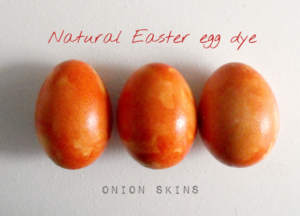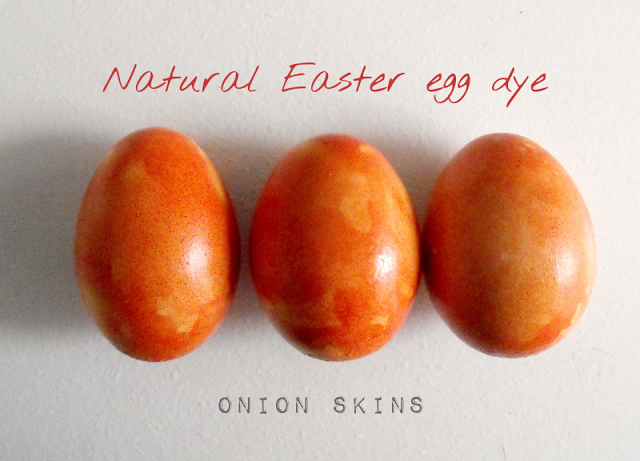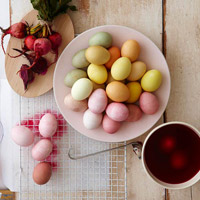It’s never too early to start planning for Easter – arranging baskets of treats for the children (and certain grown-ups I know!), baking plenty of chorag, making special desserts (paklava, for instance) – but most important, coloring hard-cooked eggs for Easter Sunday.
Special
Note: You must start gathering onion skins now – gather as many as you can because the more you have, the more intense the color will be.
This time around, I’m also including several natural egg-coloring recipes compliments of ‘Better Homes and Gardens’. You’ll find the recipes
below.
Hard cook eggs as you normally do, but add the onion skins to the water before you start the cooking process.
You’ve never hard-cooked eggs before? Here’s what you do:
1. Gently place eggs in a deep pot.
2. Add enough water to come one inch above the eggs. (Add onion skins now if you’re coloring eggs for Easter.)
3. Cook over high heat until water comes to a boil.
4. Immediately cover the pot and remove it from the heat.
5. Let the eggs stand in the hot water for 15 minutes.
6. Discard the onion skins, if used.
7. Remove the eggs from the hot water and cool them immediately in a bowl of cold water. (This stops any further cooking, makes eggs easier to peel, and helps prevent a greenish ring from forming around the yolk.)
8. Pat the eggs dry, and refrigerate them until serving time.
Use these all-natural dye recipes made from household ingredients to create Easter eggs in beautifully subdued shades. Leave eggs soaking in the dye in the refrigerator overnight for the richest colors.
Bluish-Gray:
Mix 1 cup frozen blueberries with 1 cup water, bring to room temperature, and remove blueberries.
Blue:
Cut 1/4 head of red cabbage into chunks and add to 4 cups boiling water. Stir in 2 Tbsp. vinegar. Let cool to room temperature and remove cabbage with a slotted spoon.
Jade Green:
Peel the skin from 6 red onions and simmer in 2 cups water for 15 minutes; strain. Add 3 tsp. white vinegar.
Faint Green-Yellow:
Peel the skin from 6 yellow apples. Simmer in 1-1/2 cups water for 20 minutes; strain. Add 2 tsp. white vinegar. Simmer 4 oz. chopped fennel tops in 1-1/2 cups of water for 20 minutes; strain. Add 2 tsp. white vinegar.
Orange:
Take the skin of 6 yellow onions and simmer in 2 cups water for 15 minutes; strain. Add 3 tsp. white vinegar.
Faint
Red-Orange:
Stir 2 Tbsp. paprika into 1 cup boiling water; add 2 tsp. white vinegar.
Yellow:
Rich yellow: Simmer 4 oz. chopped carrot tops in 1-1/2 cups water
for 15 minutes; strain. Add 2 tsp. white vinegar.
Mustard-yellow:
Stir 2 Tbsp. turmeric into 1 cup boiling water; add 2 tsp. white vinegar.
Various shades: Steep 4 bags of chamomile or green tea in 1 cup boiling water for 5 minutes.
Pale yellow: Chop 4 oz. goldenrod and simmer in 2 cups water for 20
minutes; strain. Add 2 tsp. white vinegar.
Faint yellow: Simmer the peels of 6 oranges in 1-1/2 cups water for
20 minutes; strain. Add 2 tsp. vinegar.
Brown-Gold:
Simmer 2 Tbsp. dill seed in 1 cup water for 15 minutes; strain. Add 2 tsp. white vinegar.
Brown:
Add 1 tablespoon vinegar to 1 cup strong coffee.
Pink:
Faint pink:
Chop 4 oz. amaranth flowers and simmer in 2 cups water; strain. Add 2 tsp.
white vinegar. Simmer the skins from 6 avocados in 1-1/2 cup water for 20
minutes; strain. Add 2 tsp. white vinegar.
Medium pink: Mix 1 cup pickled beet juice and 1 tablespoon vinegar.
Dark pink:
Cut 1 medium beet into chunks and add to 4 cups boiling water. Stir in 2 Tbsp.
vinegar and let cool to room temperature; remove beets.
Lavender:
Mix 1 cup grape juice and 1 tablespoon vinegar.






View Comments
I bet the colors are phenomenal after cooking them with onion skins.
To all of the above I must add two:
1. Yellow: In addition to the onion skins, add half a stick of hemostick (the stuff you put on your face to stop bleeding if you get a razor nick).
2. Bright Red: Get a package of the extremely unnatural and probably toxic Greek or Russian red dye at your local ethnic market and follow the directions. It will dye, not only the shells, but also part of the egg white and, did I mention it is possibly toxic? But there is absolutely no substitute. :-)